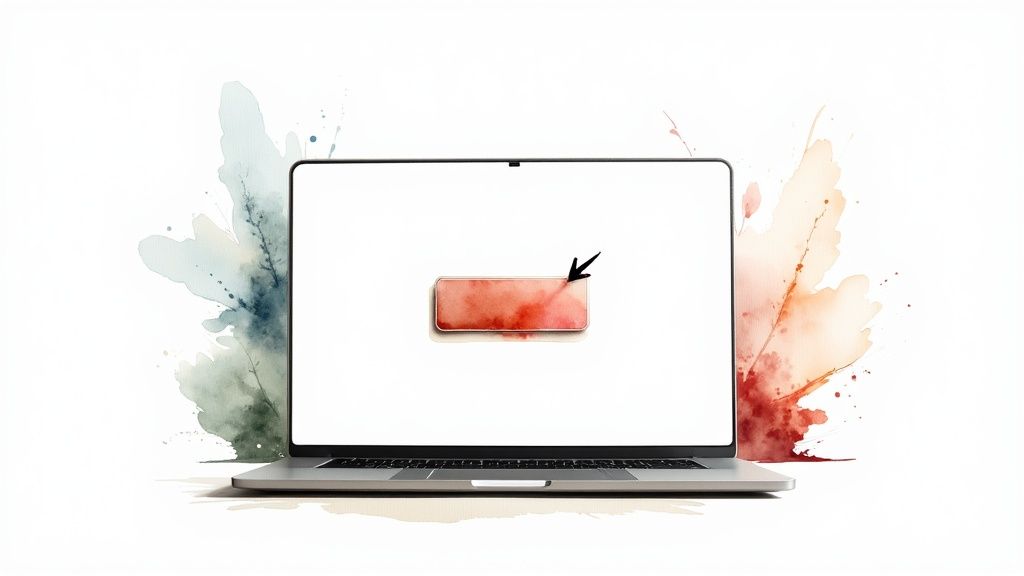8 User Onboarding Best Practices I Wish I Knew Sooner
Stop bleeding users. Learn 8 battle-tested user onboarding best practices from a founder who’s been in the trenches. No fluff, just what works.
Posted by
Related reading
Your Customer Service Isn't a Department, It's a Ticking Time Bomb
Tired of bad advice? Learn how to improve customer service by diagnosing real issues in your support tickets and delivering fixes that actually work.
Your Customer Feedback Loop Is a Joke. Fix It.
Stop guessing. Build a customer feedback loop that prints cash and stops churn. A no-BS guide for founders who'd rather build than theorize.
Ignore Your Customers And Die Broke
Discover client communication best practices that top founders use to build trust, reduce churn, and scale faster without fluff.
Let's be honest. You spent six months building a product you're convinced will change the world, only to watch 80% of your signups ghost you after five minutes. You think it's the product. It's not. It's your onboarding.
You’re throwing a user into the cockpit of a 747 and expecting them to fly. They’re not just confused; they’re insulted. They gave you their email and their time, and you repaid them with a feature-dump headache. You're not guiding them to an 'aha moment'; you're escorting them to the churn door. We've all done it. We've all built something we love and then completely fumbled the handshake.
This isn't a theoretical listicle from some content marketer. This is scar tissue—the hard-won lessons from watching thousands of users either fall in love or walk away in disgust. Ignore this, and you’ll be lucky to survive the next quarter.
To get a broader view, you can check other guides like this one on 9 Customer Onboarding Best Practices, but what follows is the unfiltered truth from the trenches. Let's fix your leaking bucket.
1. Stop Drowning Your Users (Progressive Disclosure)
Showing a new user every feature on day one is like trying to teach someone to swim by throwing them into the ocean. They will drown in complexity. Progressive disclosure is the antidote: show users only what they need, right when they need it.
This respects their cognitive limits and reduces friction. It’s grounded in Cognitive Load Theory, which basically says the human brain isn’t a supercomputer. Don't overload it. Slack doesn't throw Huddles and advanced search operators at you instantly. It starts with channels and messages. It reveals complexity only when you're ready.

How to Do It Without Overthinking
- Map It Out: Bucket your features into "Day 1," "Week 1," and "Month 1." What's the first hit of value? Gate the rest.
- Use Empty States as Teasers: An empty dashboard shouldn't be a void. It should say, "Your awesome reports will show up here once you do X."
- Create an Escape Hatch: Let power users skip the hand-holding. An "Expert Mode" prevents you from infuriating your best customers.
Takeaway: Don't feature-dump; guide them from one small win to the next.
2. Burn Your Video Tutorials (Interactive Walkthroughs)
Passive video tutorials are where user engagement goes to die. No one wants to watch a five-minute video, remember it all, and then try to apply it. Interactive walkthroughs force users to learn by doing.
They click, type, and complete actions inside your actual product. This builds muscle memory, not just passive knowledge. It’s a guide sitting next to them, pointing out exactly where to click. Calendly doesn't just show you how to create a link; it walks you through creating one, ensuring you get the value prop in minutes.

How to Make It Work
- Focus on the Core Win: Your tour has one job: guide the user through the single most important workflow. Nothing else matters.
- Keep It Short: 5-7 steps, max. An abandoned tour is a failed tour.
- Make It Skippable: Forcing a tour on someone is a hostile act. But track the skip rate—a high rate means your tour sucks.
- Celebrate the Win: A simple "Congrats!" or a checked-off task provides a hit of dopamine that keeps them going.
Takeaway: Stop telling, start guiding; make them achieve their first win themselves.
3. One-Size-Fits-None (Personalized Onboarding Paths)
Treating every user the same is a death sentence for engagement. A Fortune 500 marketer and a solo founder have different needs, yet you force them down the same welcome flow. Stop it.
Personalized onboarding uses a few smart questions at signup to deliver a tailored experience based on a user's role or goals. The principle is ruthless relevance: cut the noise and show them how your product solves their specific problem, right now. To see the impact, learn how personalization boosts customer engagement.

How to Nail It
- Ask Smart, Not More: 2-3 questions max. Focus on role, primary goal, or team size. Anymore, and you’re creating friction.
- Segment Your Welcome: Create different checklists, tooltips, and email sequences for each segment. Show the marketer analytics; show the developer the API docs.
- Allow Course Correction: People make mistakes or change roles. Let them switch their path in account settings.
Takeaway: Stop the generic tour; show each user you understand their specific pain from the first click.
4. Don't Leave Them in an Empty Room (Empty State Design)
A blank screen is a dead end. It’s confusing, awkward, and it screams "leave." A well-designed empty state turns this void into a guided starting point.
It shouldn't signal absence; it should signal opportunity. It's your chance to tell the user exactly what to do next to get value. GitHub’s empty repo doesn’t just sit there; it gives you clear commands to populate it. It replaces confusion with clarity.

How to Make It Useful
- Show the End Goal: Use illustrations or mockups of what the screen will look like when it's full. Let them visualize the promised land.
- Give Them Options: Provide a primary CTA ("Create First Project") alongside secondary ones ("Import from CSV" or "Use a Template").
- Use Benefit-Oriented Copy: Instead of "No data," say, "Your sales dashboard lives here. Connect your CRM to see the magic."
- Make the CTA Unmistakable: Use a big, high-contrast button. "Add Your First Client" beats "Submit" every time.
Takeaway: An empty screen is a prime opportunity to guide the user's first action.
5. Get to the "Aha!" Moment Faster (Time-to-Value)
Users sign up to solve a painful problem, not to watch tutorials. They have the attention span of a goldfish. Time-to-value (TTV) is about ruthlessly cutting the distance between signup and the moment they experience your product’s core benefit.
Your only goal is to get the user to a win as fast as humanly possible. This first taste of value is the hook. As onboarding expert Samuel Hulick of UserOnboard shows, products that master this create a powerful first impression that fuels retention. A low TTV proves your worth before their excitement fades.
How to Cut the Crap
- Define Your "Aha Moment": What's the one action that delivers the core promise? For Facebook, it was 7 friends in 10 days. Find yours.
- Map the Journey: Draw out every single click from the homepage to that "aha." Every step is friction. Eliminate it.
- Use Templates & Samples: Don't start with a blank slate. Give them sample projects or pre-filled data so the product feels alive.
- Defer Everything Else: Do they really need to upload a profile pic and configure notifications before getting value? No. Postpone it.
Takeaway: Your first job is to deliver a win, not a comprehensive tour.
6. Help Them Where They Are (In-App Messaging)
Expecting users to hunt through a knowledge base when they get stuck is lazy. Most will just churn. In-app messaging delivers guidance exactly when and where it's needed, directly within your product.
This isn't about annoying pop-ups. It’s about anticipating confusion and offering help proactively. When a user hovers over a complex feature, a small tooltip explains its value. It turns help from a chore into a seamless part of the flow.
How to Be Helpful, Not Annoying
- Use Behavioral Triggers: Trigger messages based on user actions (or inaction). If they create a project but don't invite a collaborator after 48 hours, prompt them.
- Segment Your Guidance: Don't show beginner tips to power users. That's insulting.
- Keep It Conversational & Dismissible: Write like a human. And always, always give them an easy way to close the message.
- Use Engagement as Feedback: Track which prompts get used. If many users need help with a specific feature, the feature's design is the problem. Use this data to build better feedback forms on backsy.ai to dig deeper.
Takeaway: Bring the answers to the user before they even have to ask.
7. The Conversation Doesn't End at Logout (Onboarding Emails)
Ignoring the inbox is like ghosting a new friend. You’ll be forgotten. Onboarding email sequences are your secret weapon for extending the conversation beyond the app.
This isn't spam. It’s about delivering the right nudge at the right moment to pull users back. A well-crafted sequence celebrates their wins, reminds them of the next step, and showcases value they haven't unlocked yet. Duolingo's streak reminders aren't just notifications; they are masterfully crafted behavioral triggers.
How to Write Emails That Don't Get Deleted
- Trigger, Don't Time: Ditch the time-based drip. Did they create a project but not a task? Send a "1-click to add your first task" email.
- One Goal Per Email: Every email should have one job. Don't cram three feature highlights into one message. A single, clear CTA is king.
- Know When to Shut Up: Once a user is activated, graduate them from the onboarding campaign. Sending "getting started" tips to a power user is just noise.
Takeaway: Use the inbox to keep the momentum going when they're not in the app.
8. Build a Damn Good Library (Self-Service Resources)
Your onboarding can’t anticipate everything. Forcing users to contact support for every question is a recipe for churn. A great knowledge base empowers users to find their own answers.
Treat your documentation as a core product, not an afterthought. Your help center isn't a cost center; it's a retention tool. World-class docs, like Stripe's, become a competitive advantage. This self-guided success is a key driver for your SaaS customer retention strategies.
How to Make Docs People Actually Use
- Organize by Goals, Not Features: Structure your help center around what users are trying to do ("How to launch a campaign"), not your product's internal jargon.
- Make it Visual: Use annotated screenshots, GIFs, and short videos. A wall of text is a user-repellent.
- Invest in Search: Your knowledge base is useless if the search sucks.
- Use Data to Find Gaps: Analyze what people are searching for. If queries return no results, that’s your content roadmap.
Takeaway: A great help center empowers users and frees up your support team for real problems.
User Onboarding Best Practices Comparison
| Onboarding Strategy | Implementation Complexity 🔄 | Resource Requirements 🔄 | Expected Outcomes 📊 | Ideal Use Cases 💡 | Key Advantages ⭐⚡ |
|---|---|---|---|---|---|
| Progressive Disclosure | Medium to High (UX planning needed) 🔄🔄 | Moderate (design & development) 🔄 | Reduced cognitive load, higher retention 📊⭐ | Feature-rich apps, gradual learners 💡 | Lower overwhelm, supports novices ⭐ |
| Interactive Walkthroughs & Tours | High (development & maintenance) 🔄🔄🔄 | High (dev resources and updates) 🔄 | Active learning, task completion, fewer support tickets 📊⭐ | Complex workflows, feature demos 💡 | Hands-on engagement, multi-step guidance ⚡ |
| Personalized Onboarding Paths | High (segmentation & logic) 🔄🔄🔄 | High (data analysis & testing) 🔄 | Higher relevance, faster time-to-value 📊⭐ | Diverse user bases, role-specific needs 💡 | Tailored experience increases engagement ⭐ |
| Empty State Design with CTAs | Low to Medium 🔄 | Medium (design & copywriting) 🔄 | Clear next steps, reduced confusion 📊 | Content creation tools, data-driven apps 💡 | Positive empty experience, quick activation ⚡ |
| Time-to-Value Optimization | Medium to High 🔄🔄 | Medium (journey mapping & analytics) 🔄 | Fast core value delivery, higher activation 📊⭐ | Products needing quick impact 💡 | Early success boosts retention ⭐⚡ |
| In-App Messaging & Contextual Help | Medium to High 🔄🔄 | Medium to High (content creation & integration) 🔄 | On-demand help, reduced support tickets 📊 | Feature adoption, complex UIs 💡 | Contextual guidance increases adoption ⭐ |
| Onboarding Email Sequences | Medium 🔄 | Low to Medium (automation & content) 🔄 | Maintains engagement, re-engagement 📊 | Long onboarding timelines, spaced education 💡 | Scalable, personalized outreach ⭐ |
| Self-Service Resources & Docs | High (content creation & upkeep) 🔄🔄🔄 | High (ongoing updates & organization) 🔄 | User empowerment, support deflection 📊 | Technical or complex products 💡 | 24/7 support, scalable learning ⭐ |
Your Perfect Plan is a Guess
So, you've followed the playbook. You're ready to build the onboarding flow that finally crushes churn.
But here’s the hard truth: the best-designed onboarding flow is still just a hypothesis. It’s an educated guess. Because you aren't your user. You can’t replicate the confusion of a first-time login or the impatience of a busy professional.
Your analytics dashboard is a liar. It tells you what happened—the drop-off point, the unclicked button. It screams "problem here" but whispers nothing about the why. Was the UI confusing? Was the copy unclear? Your funnel charts can't answer that.
The biggest mistake founders make isn't a bad product tour; it’s the arrogance of believing their plan is flawless. They A/B test button colors while users are fundamentally misunderstanding the core value. They look at heatmaps and session recordings, which are like watching a silent movie with no subtitles. You see the action, but you miss the plot.
The only way to move from guessing to knowing is to get inside your user’s head. You need to know why they bailed at step three. You need to find the friction they won't email you about. You need to capture their "aha!" moment and replicate it for everyone else.
Implementing these best practices gets you on the field. Listening to your users is how you win.
Stop guessing what's broken in your onboarding and get the why behind the clicks by asking your users directly in the app with Backsy.